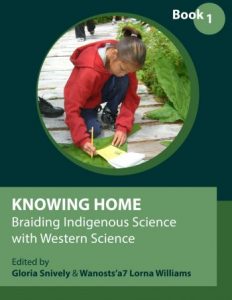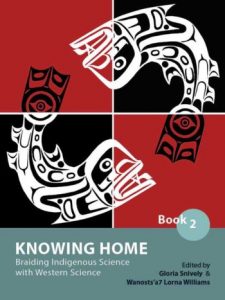When we braid Indigenous Science with Western Science we acknowledge that both ways of knowing are legitimate forms of knowledge.
I believe both of these books will prove to be useful not only for my research journey but for educators everywhere. Both of these books are free for download too! The relationship between Indigenous science and Western science is an important one. I think it touches on many points we have previously discussed in this course including Indigenous perspectives, world views, and ties them into science teachings and curriculum. It highlights another critical theme in Indigenous culture, the importance of place, and how this is interweaved with identity.
Together, the co-editors and authors, almost all of them Aboriginal, present multiple useful paths towards identifying and recognizing two huge shortfalls in the Canadian educational system to date. One is the abysmal failure of many schools to provide quality education for Aboriginal children and youth, particularly in the areas of science, technology, and health. This situation is reflected today in the marked underrepresentation of Aboriginal students participating in university-level programs in these areas, and, further, in the dearth of professional scientists from Aboriginal communities across the country. The second gap, equally lamentable, is that students of mainstream western science and technology have been deprived of learning about the immense body of Indigenous scientific knowledge, perspectives, and applications acquired and built over generations of dwelling in particular places. Knowing Home… will be a wonderful resource that will bring all Canadians to a higher level of understanding in these two areas.
Book 1 provides an overview of why traditional knowledge and wisdom should be included in the science curriculum, a window into the science and technologies of the Indigenous peoples who live in Northwestern North America, Indigenous worldview, culturally responsive teaching strategies and curriculum models, and evaluative techniques. It is intended that the rich examples and cases, combined with the resources listed in the appendices, will enable teachers and students to explore Indigenous Science examples in the classroom; and in addition, support the development of culturally appropriate curriculum projects.
Book 2 provides supportive research, case studies, and commentary that extends and enriches the chapters presented in Book 1. The chapters provide rich descriptions related to Indigenous cultural beliefs and values; an Aboriginal concept of time; transforming teacher thinking about Indigenous Science; the use of digital video as a learning tool for secondary Aboriginal students; the perceptions and experiences of post-secondary Aboriginal students during science instruction; a WSÁNEĆ concept of “knowledge of most worth”, and a study of successful Aboriginal students in secondary science.
Snively, G. & Williams, W. (2016). Knowing Home: Braiding Indigenous Science with Western Science Book 1. University of Victoria. https://pressbooks.bccampus.ca/knowinghome/
Snively, G. & Williams, W. (2018). Knowing Home: Braiding Indigenous Science with Western Science Book 2. University of Victoria. https://pressbooks.bccampus.ca/knowinghome/


Thanks for sharing Jamie! Love that this resource supports the inclusion of Indigenous teachings in our curriculum. Also love that it I can download it! Thanks!
Hi Jamie, Thanks for sharing this resource. I have been seeking out more information on weaving in traditional knowledge with science and in particular with place based learning. Much of our learning in our school has been place based but we struggle to weave in more Indigenous knowledge and culture.